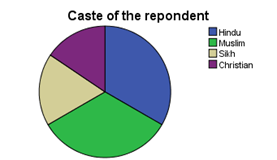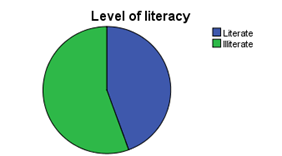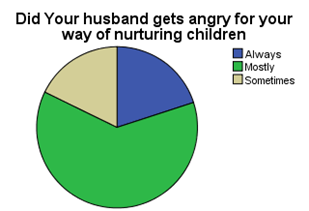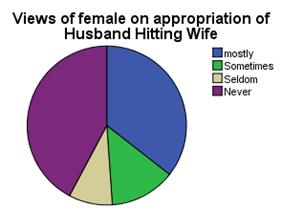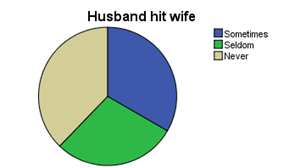Role of Social Norms and Culture in Gender Violence
- Dr. Sarika Dixit
- 339-349
- Jan 11, 2024
- Social Welfare
Role of Social Norms and Culture in Gender Violence
Dr. Sarika Dixit
Registrar and Dean,
Mahatma Gandhi University, Meghalaya
DOI: https://doi.org/10.51244/IJRSI.2023.1012027
Received: 07 December 2023; Revised: 26 December 2023; Accepted: 30 December 2023; Published: 10 January 2024
ABSTRACT
Gender violence is a complex issue deeply woven into the fabric of many societies. Norms and culture play a significant role in perpetuating and justifying this violence by shaping societal expectations, gender roles, and power dynamics. Rigid gender norms can create a climate where men are expected to be dominant and aggressive, while women are expected to be submissive and passive. This creates an uneven playing field where violence against women is often seen as acceptable, even expected, behavior. Cultural beliefs and traditions can further reinforce these norms, for example, through practices like child marriage, female genital mutilation, or honor killings. These harmful practices not only directly violate women’s rights and safety but also normalize the idea of male control and female subordination, creating a breeding ground for further violence. Understanding the intricate interplay between norms, culture, and gender violence is crucial for dismantling these harmful structures and building a society where all individuals can live free from fear and discrimination.
Gender norms are the cultural messages we all get about the way men and women are “supposed” to be. Tropes like boys will be boys. Take it like a man. A woman’s place. Act like a lady. Sometimes these messages are indirect, implied, or invisible; others, direct, specific, and overt. These norms affect us all consciously or otherwise.
Therefore is study focused on analyzing the prevalence of gender violence and also to find out the role of social norms and culture in abetting gender violence?
Objectives of the study
- To find out the role of social norms in abetting gender violence.
- To find out the views of women on already established social norms.
Keywords: Social Norms, Culture, Gender, Violence
INTRODUCTION
Like threads through a tapestry, norms and culture intricately weave a society’s attitudes and behaviors. This intricate pattern can, unfortunately, also hold embedded threads of power imbalance and inequality, which can tragically manifest in gender-based violence. Societal expectations around masculinity and femininity, often rigid and skewed, can set the stage for harmful dynamics where aggression and dominance become associated with men, while vulnerability and submissiveness become linked to women. This creates a landscape where violence against women can be viewed with alarming leniency, even justification, fueled by cultural beliefs and traditions that normalize male control and female subordination. To truly uproot gender violence, we must unravel these harmful threads within the social fabric, examining how norms and culture shape expectations, reinforce power imbalances, and ultimately, contribute to a world where safety and equality remain elusive for too many.
Social norms are the unwritten (or sometimes written) rules of society that differ from culture to culture, and make up what’s seen as normal, acceptable, respectful behavior. But a lot of our relationships with people are governed by social norms, not prices and money. Social norms govern most of our relationships with our family members as well.
Women are usually the victim of domestic violence that derives from unequal power relationships between men and women. Violence in the domestic sphere usually perpetrate by husband/intimate partner. Domestic violence against women is major obstacle on progress on achieving development targets.
About 88 % of rural and 69 % of urban women believe that their husbands have the right to beat them. (Mengistie, 2015)
Social and cultural norms are highly influential over individual behavior in a broad variety of contexts, including violence and its prevention, because norms can create an environment that can either foster or mitigate violence and its deleterious effects.
According to the United Nation’s Population Fund, 1 in 3 women have experienced physical or sexualized violence in their lifetime. That is not including emotional, financial, or verbal abuse. It encompasses threats of violence and coercion. It can be physical, emotional, psychological, or sexual in nature, and can take the form of a denial of resources or access to services. It inflicts harm on women, girls, men and boys. (UNHHCR)
Acceptance of violence as a ‘private affair’ often prevents others from intervening and prohibits girls and young women from reporting. In many cultures, violence towards girls and young women is accepted as a social norm. This must be challenged as a matter of urgency, and the blame, shame and stigma faced by victims must be eliminated.
Social norms are the unwritten (or sometimes written) rules of society that differ from culture to culture, and make up what’s seen as normal, acceptable, respectful behavior. But a lot of our relationships with people are governed by social norms, not prices and money. Social norms govern most of our relationships with our family members as well.
Women are usually the victim of domestic violence that derives from unequal power relationships between men and women. Violence in the domestic sphere usually perpetrate by husband/intimate partner. Domestic violence against women is major obstacle on progress on achieving development targets.
About 88 % of rural and 69 % of urban women believe that their husbands have the right to beat them. (Mengistie, 2015)
Social and cultural norms are highly influential over individual behavior in a broad variety of contexts, including violence and its prevention, because norms can create an environment that can either foster or mitigate violence and its deleterious effects.
Gender norms are the cultural messages we all get about the way men and women are “supposed” to be. Tropes like boys will be boys. Take it like a man. A woman’s place. Act like a lady. Sometimes these messages are indirect, implied, or invisible; others, direct, specific, and overt. These norms affect us all – consciously or otherwise.
Witnessing violence in childhood creates norms that can lead to the acceptance or perpetration of a multitude of violent behaviors or acts, but it also may provide a potent point of intervention for violence prevention efforts. Although research in this area is limited, many preliminary studies show promise in actively influencing or altering existing social norms in order to reduce the occurrence of violence within a given population (WHO, 2009).
Gender-based discrimination and violence are the result of a patriarchal social order and a global power paradigm that emphasizes vertical power structures that reinforce inequality. Moreover, this paradigm and the resulting forms of violence and discrimination are perpetuated by and expressed through social and cultural norms and practices around gender and sexuality.
Therefore is study focused on analyzing the prevalence of gender violence in Indian context and also to find out the role of social norms and culture in abetting gender violence?
REVIEW OF LITERATURE
Kishwar, Madhu (1986) in her study dowry to ensure her happiness or to disinherit her” feels that oppression of wives for bringing inadequate dowry is only another excuse for using violence against them: in other words and in fact evidence from other country has indicted as much even without additional tradition of dowry, inter spousal violence is endemic. She has also pointed out that dowry payments in themselves do not Trans from girls in to burdens but rather dowry makes daughter burdensome only because daughter are unwanted to being with”.
Elise Bonding (1988) in her paper on women & social violence clearly points out that social violence against women are mainly based on a (a) social or institutional structure of the patriarchal order perpetuating all kinds of discrimination and oppressions against women which result into (b) behavioral violence. In general, she reports that because women are ‘easy’ victims, they experience a great deal of direct behavioral violence in every society. Of the most common expressions of behavioral violence against themselves women as victims find involved in rape, wife-beating and prostitution all over the world.
David Levinson (1989) outlines three other factors that together help predict violence against women: a pattern of using physical violence for conflict resolution, male authority in the home, and a divorce restriction for women. In the current study in Gujarat, only three women reported dowry related violence. This low number may be due to higher prevalence of dowry harassment in urban, higher caste families not represented in a rural sample. The Gujarat findings support Levinson’s predictors of violence. The lack of women’s power within the home as well as constraining social and economic factors which provide few options outside of marriage were indeed associated with high levels of abuse.
Kapur and Cossman (1996) opined that despite the enactment of laws, not much has changed for women in India. They ascribe the failure of laws to bring about change within a patriarchal structure to the concept of the family, which is seen as a “basic sacred unit in society,” and “women’s roles as wives and mothers as natural and immutable.” These strictures form the guiding ideology underlying the laws. According to them, another problem with the Indian legal system is the “protectionist” stance taken by laws pertaining to women that may end up “reinforcing relations of subordination.”
Jeebhoy (1998) is of the view of that wife beating is not only deeply entrenched but also justified. Thus, domestic violence is simply not a personal abnormality but rather has roots in the cultural norms of the family and the society. However, it is expected that women who work at a regular job, who earn cash, and who perceive that their contribution is a substantial part of total family earnings are more likely to be empowered than other employed and unemployed women in the household (Youssef, 1982 Sen, 1990).
Mitra (2000), in her exhaustive report on domestic violence in India conducted by the Tata Institute of Social Sciences, concluded that as long as there is tolerance of domestic violence toward women in cultural, legal, and political institutions, laws in themselves will not change the situation. She continued that what is required is “appropriate behavioral and social changes” along with efficient enforcement of laws. If laws are created to “protect” women, they are done “within” the system. This, in turn, reinforces culturally legitimized social hierarchies.
Objectives of the study
- To find out the role of social norms in abetting gender violence.
- To find out the views of women on already established social norms.
METHODOLOGY
Research Design: Descriptive Research Design
Area of Study– Kasrawad and Khurd village of Indore
Universe – Scheduled Tribe females 314
Sample size – 45
Sample unit – 1 women
Sampling method– convenient Non-probability Sampling
Methods of data collection – Interview
Primary data – Through Interview schedule
Secondary data – Books, Journals, census, reports etc.
Results
| Caste of the respondent | ||
| Frequency | Percent | |
| Hindu | 15 | 33.3 |
| Muslim | 15 | 33.3 |
| Sikh | 8 | 17.8 |
| Christian | 7 | 15.6 |
| Total | 45 | 100.0 |
| Level of literacy | ||
| Frequency | Percent | |
| Literate | 20 | 44.4 |
| Illiterate | 25 | 55.6 |
| Total | 45 | 100.0 |
| Monthly Income of the respondent | ||
| Frequency | Percent | |
| No income | 24 | 53.3 |
| 1000-10000 | 21 | 46.7 |
| Total | 45 | 100.0 |
| female hit husband | ||
| Frequency | Percent | |
| Never | 45 | 100.0 |
- It is surprising to note that 100 per cent of the female reported that they never hit their husband.
| Age of the respondent | ||
| Frequency | Percent | |
| 15-25 | 11 | 24.4 |
| 26-35 | 16 | 35.6 |
| 36-45 | 9 | 20.0 |
| above 46 | 9 | 20.0 |
| Total | 45 | 100.0 |
| Did Your husband gets angry for your way of nurturing children | ||
| Frequency | Percent | |
| Always | 9 | 20.0 |
| Mostly | 28 | 62.2 |
| Sometimes | 8 | 17.8 |
| Total | 45 | 100.0 |
- Around 62 per cent of the females agrees that husband mostly gets angry about the way a wife nurtures the child.
| Views of female on appropriation of Husband Hitting Wife | ||
| Frequency | Percent | |
| Mostly | 16 | 35.6 |
| Sometimes | 6 | 13.3 |
| Seldom | 4 | 8.9 |
| Never | 19 | 42.2 |
| Total | 45 | 100.0 |
- Trend here suggests that about 42 per cent of the females’ views that it is never appropriate if a husband hits his wife.
| Husband hit wife | ||
| Frequency | Percent | |
| Sometimes | 15 | 33.3 |
| Seldom | 13 | 28.9 |
| Never | 17 | 37.8 |
| Total | 45 | 100.0 |
Around 33 per cent of the females reported that their husband hit them sometimes, around 28 per cent females reported that their husband seldom hit them. About 37 per cent females reported that their husband never hit them
| Consideration of female that husband can hit them | ||
| Frequency | Percent | |
| Mostly | 2 | 4.4 |
| Sometimes | 16 | 35.6 |
| Seldom | 14 | 31.1 |
| Never | 13 | 28.9 |
| Total | 45 | 100.0 |
- Around 35 per cent of the females considers it right that it is fine sometimes that husband can hit them. Also 31 per cent of the females consider it fine if husband hits them seldom. About 27 per cent of the females supports the view that it’s never fine that a husband can beat his wife.
| Did your husband gets angry when you leave home without asking | ||
| Frequency | Percent | |
| Always | 13 | 28.9 |
| Mostly | 19 | 42.2 |
| Sometimes | 4 | 8.9 |
| Seldom | 4 | 8.9 |
| Never | 5 | 11.1 |
| Total | 45 | 100.0 |
- About 42 per cent of the females supports the view that their husband gets angry when they leave home without their permission. Also about 28 per cent of the females supports the view that husband always gets angry.
| Did your husband hit you when the food is not properly prepared | ||
| Frequency | Percent | |
| Always | 4 | 8.9 |
| Mostly | 12 | 26.7 |
| Sometimes | 6 | 13.3 |
| Seldom | 9 | 20.0 |
| Never | 14 | 31.1 |
| Total | 45 | 100.0 |
- About 26 per cent of the females agrees that husband always gets angry when they don’t like the food.
DISCUSSION
As we have seen in the review of past studies that social violence against women are mainly based on a (a) social or institutional structure of the patriarchal order perpetuating all kinds of discrimination and oppressions against women which result into (b) behavioral violence. Jeebhoy (1998) is of the view that wife beating is not only deeply entrenched but also justified. Thus, domestic violence is simply not a personal abnormality but rather has roots in the cultural norms of the family and the society. So our data supports this view.
SUGGESTIONS
There are many different ways of understanding norms, which reflect the approaches of different academic disciplines – and all can help shed light on what norms are and how they contribute to upholding gender inequalities.
- Continued investments in education for all is essential, including investments in the quality of education.
- Continued support is needed for policy approaches that encourage gender equality in education.
- Gender-based violence in schools must also be addressed.
Dismantling the entrenched influences of norms and culture on gender violence requires a multi-pronged approach targeting both individual mindsets and societal structures. Here are some suggestions:
Shifting Individual Perspectives:
- Education and awareness: Comprehensive education programs for all ages can challenge harmful stereotypes, promote gender equality, and cultivate empathy towards survivors. This includes educating boys about healthy masculinity and respectful behavior.
- Critical thinking and questioning: Encouraging critical thinking about societal norms and traditions can empower individuals to identify and challenge sexist assumptions and biases.
- Bystander intervention training: Equipping individuals with skills to safely and effectively intervene in potentially harmful situations can prevent violence before it occurs.
Transforming Societal Structures:
- Legislative changes: Strengthening laws against gender-based violence, ensuring swift and transparent judicial processes, and providing robust support systems for survivors are crucial steps towards accountability and deterrence.
- Media representation: Challenging stereotypical portrayals of genders and promoting positive narratives that showcase healthy relationships and diverse female role models can reshape societal perceptions.
- Community engagement: Mobilizing communities through awareness campaigns, engaging local leaders, and supporting grassroots initiatives can create a unified front against gender violence.
- Economic empowerment of women: Providing access to education, employment opportunities, and financial independence can give women greater agency and control over their lives, reducing their vulnerability to violence.
It’s important to remember that tackling gender violence is a long-term effort that requires collective action and sustained commitment. By focusing on both individual empowerment and broader systemic changes, we can gradually unravel the harmful threads woven into our norms and cultures, paving the way for a society where everyone feels safe and respected.
CONCLUSION
The main hindrances to acknowledging gender equality in India are profound situated social norms. A large part of money have been poured into development programmes and women’s empowerment, however, this still can’t seem to yield critical change, especially with respect to Indian culture. At the point when strengthening clashes with Indian culture, it isn’t generally welcomed. India’s long and different history makes it a nation of complexities and polarities. While on a few fronts the nation is well into the 21st century, its profound established conventionalism has eased back its pace on others. For change to be continued, it must be slow and be established in acknowledgment. Eventually, for women in India to change cultural norms, they need the money and family support. We have to change the arrangement of social norms in India that keep women subordinate. Men additionally should understand that women can work without relinquishing their families and their duties in the home. A change in social norm is a long term process, as it is a change in behaviours of individuals and collectives. This involves a great deal of self-reflection and honesty, something that is not easy to do in a short span of time. When a critical mass of individuals displays changed behaviour that is when social norms will change.
Remember, everyone has a role to play in creating a world free from gender violence. Let’s work together to break the cycle and build a more just and equitable future for all.
REFERENCES
- Gender-Based Violence (Violence Against Women and Girls). (2019, September 25). Retrieved from The World Bank: https://www.worldbank.org/en/topic/socialdevelopment/brief/violence-against-women-and-girls
- International, P. (n.d.). GENDER-BASED VIOLENCE. Retrieved from https://plan-international.org/ending-violence/gbv-gender-based-violence
- McLeod, S. (2008). Simply Psychology. Retrieved from Social Psychology: https://www.simplypsychology.org/social-roles.html
- Mengistie, A. S. (2015). Domestic violence against women and associated factors in Ethiopia; systematic review. Reproductive Health.
- Ott, M. (2017, November 21). Series: What Does That Mean? Gender-based Violence. Retrieved from Women for Women: https://www.womenforwomen.org/blogs/series-what-does-mean-gender-based-violence
- (n.d.). Sexual and Gender Based Violence. Retrieved from The UN Refugee Agency: https://www.unhcr.org/sexual-and-gender-based-violence.html https://www.theguardian.com/women-in-leadership/2015/jul/21/learning-from-cultural-differences-key-to-womens-empowerment https://www.oxfamindia.org/5-questions-will-explain-everything-on-social-norms

